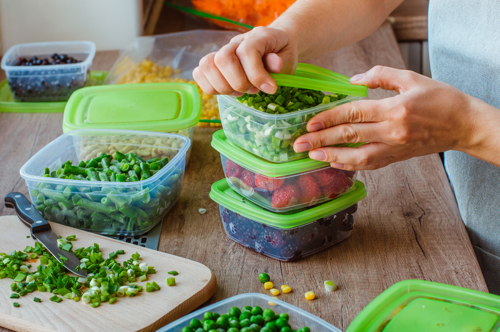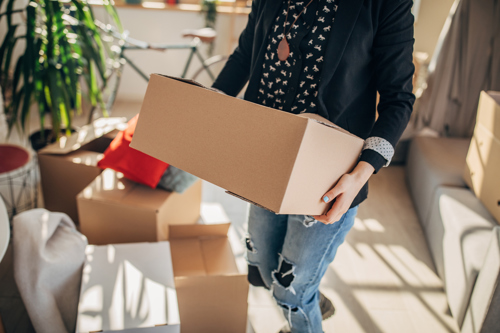The idea of “minimalism” may inspire thoughts of bare, undecorated walls, capsule wardrobes and intense frugality. But the truth is that minimalism is more of an attitude or lifestyle rather than a “look” or code. In fact, you can start experiencing the benefits of a minimalist lifestyle (fewer stressors, more clarity and calm) by making a few small tweaks to how you live and work. But before you Marie Kondo your entire living room, read up on our favorite steps to becoming a minimalist.
1. How to Live Minimally
Aggressively decluttering your home without a strategy can leave you worse off than you started. The first step to becoming a minimalist is to be mindful of your motivations. What are your top three or four goals? Are you trying to have more space to entertain guests or do your at-home workouts? Is your old furniture no longer serving your new living room color scheme or aesthetic? Understanding the whys of your decluttering plans can help you better execute on the hows.
| Pro Tip: From an environmental or “Zero Waste” perspective, throwing everything out at the beginning of your minimalism journey can be harmful. (And expensive.) Instead of throwing everything out, consider how you can upcycle or make creative use of items you “don’t need.” |
2. Benefits of Living With Less
Minimalist living comes with more perks than just increased space. Here are some of the long-term benefits you can expect from living with less:
- More money. Money can’t buy happiness, but having more money in your bank account as a result of spending less is always a win. Being selective about your purchases — and investing in high-quality items that can perform more than one task — means you’ll have extra cash to invest or treat yourself with.
- More joy. Marie Kondo took the world by storm with her concept of only keeping items that “spark joy.” Whether or not you embrace her full program, the truth is that surrounding yourself with less junk and more joy-inducing, practical items can lead to greater day-to-day well-being.
- More mindfulness. In a way, living like a minimalist is a form of meditation. You’re paying attention to what’s in front of you, and making intentional decisions about how you spend your money and what you add to your space.
- More time. Shopping isn’t just expensive — it’s time-consuming. Living like a minimalist can help you win back time you’d otherwise spend surfing for discounts and deals.
3. Set Goals
Aggressively decluttering your home without a strategy can leave you worse off than you started. The first step to becoming a minimalist is to be mindful of your motivations. What are your top three or four goals? Are you trying to have more space to entertain guests or do your at-home workouts? Is your old furniture no longer serving your new living room color scheme or aesthetic? Understanding the whys of your decluttering plans can help you better execute on the hows.
4. Store Your Stuff Seasonally
You’ll naturally end up clearing out a good portion of space in your home when the seasons turn. Christmas lights, for instance, are no good to you in the spring, and you should put summer camping equipment away about the time you bring out your Halloween or Thanksgiving decorations. Winter coats and bedding are bulky and unnecessary when the temperatures climb above freezing. Take inventory of the larger stuff you own and when you’ll likely want or need those items. Then organize your personal storage accordingly in bags or bins (with clear labels that show contents).
| Pro Tip: Like your decor and wardrobe, you can divide your major household cleaning and organizing chores according to season. Spring is usually the time of year to deep-clean in preparation for the warm weather, but don’t forget to prep your yard for summer barbecues before the June or July heat hits. Similarly, the cooler months of fall and winter are perfect for party planning and organizing your garage. |
5. Take Up Meal Prep
One of the biggest time-sucks and sources of kitchen clutter is meal prep. Scrambling to decide what’s for dinner, managing leftovers and making grocery lists can actually take quite a bit of planning, especially if you’re feeding more than one or two people. The last thing you want to deal with after a long day at work is the hassle of prepping vegetables and meats, cooking them and then dealing with all the dirty dishes after. Consider dedicating a single day each week to meal prep. Though it may feel like an intrusion on your Sunday wind-down plans, meal prep can save you a lot of stress and time throughout the week.
As you come across recipes or note down your cravings throughout the week, compile a shopping list of all the ingredients you’ll need to purchase during your grocery run. If possible, try to substitute herbs and spices with ones you already have (it’s wasteful to buy jars and jars of seasonings you’ll only use a few times a year). Then, clear out an afternoon to wash and chop your vegetables; trim, cut and marinate any meats you plan on preparing (or storing them in the freezer for later in the week); and make any dressings, condiments or sauces ahead of time. That way, you can just pull everything out of the fridge and spend half an hour or less cooking them through for fresh, hot meals every day.
For next-level meal preppers, avoid turning on the stove (and cut back on dishes) all week long by fully cooking a week’s worth of meals and portioning them evenly in glass Pyrex containers to easily transport to the office or heat up at home.
| Wondering the proper way to store your grocery haul in your kitchen? Check out our guides on organizing your pantry. |
6. Limit New Items in Your Life
As you make the move to a minimalist lifestyle, avoid the temptation to buy unnecessary items. It’s easy to say yes to everything and find yourself back where you started — in need of a major declutter to get your life back under control. Whether it’s “cheap” kitchen gadgets, jewelry you’ll probably rarely wear or even free swag bags and flyers at events, saying “no” to single-use or low-value items will go a long way to keeping your home (and life) free of distracting clutter. Remember that even though price isn’t always indicative of quality, doing your research and splurging on more expensive — but longer-lasting or multipurpose — clothes, appliances, shoes, mattresses and more will save you a lot of money in the long run.
7. Sell or Donate Unused Items, Especially Furniture
Decluttering your life doesn’t immediately mean throwing everything away — that just moves your disposable goods from one area to another (the landfill). Though minimalism isn’t affiliated with the Zero Waste Movement in any way, there’s a lot every minimalist can learn from the Zero Waste lifestyle, especially its emphasis on reusing and recycling. Instead of throwing out an old shirt, try cutting it into strips to make your own kitchen rags, or setting up a free neighborhood library on your driveway to pass any old, unwanted books to new hands and shelves.
For larger and more expensive items, like furniture, it’s likely that you can offset the initial cost of your purchase by selling them on Facebook Marketplace or Craigslist, especially if they’re in good-to-great condition. To increase the chances of making a sale, you’ll need to set aside a bit of time to take well-lit, high-quality photos and drum up a catchy, clear listing headline and description, but it’ll all be worth it in the end.
8. Use Multipurpose Items Whenever Possible
You don’t have to commit to “Swiss Army Knife” products in every area of your life to be a minimalist (so no need to force yourself to buy the two-in-one face and body wash). That said, there are plenty of ways that multipurpose items can save you money and space. Multicookers like the Instant Pot (which can pressure cook, steam, make rice and yogurt, and even act as a slow cooker) can consolidate several bulky kitchen items and save you an enormous amount of pantry or cabinet room, and having black or neutral-colored boots, shirts, jackets and pants in your wardrobe can be used to mix and match dozens of distinct outfits.
| Pro Tip: Living in a small apartment, tiny house or condo? Try some of the multipurpose storage solutions in our Small Space Hacks for the Living Room, Bedroom and Bathroom. Or check out our Ultimate Guide to Maximizing Space in a Small Apartment. |
9. Downsize to a Smaller Space
If you’re a recent empty-nester or moving from the suburbs to an expensive, crowded city, you might be wondering how to deal with all your stuff. Storage units are always an option, but downsizing itself is a challenging step even for a self-proclaimed minimalist. But with less square footage (and often a smaller yard as well as fewer rooms, bathrooms and floors), you’ll start to see a lot of the benefits of downsizing: cheaper utilities, less time spent on cleaning and maintenance. Don’t feel rushed to downsize — the process of staging and selling your home can be long and stressful, and you’ll want to make sure you have a clear schedule and strategy before you start.
|
Need help planning your move? Check out these helpful guides: |
10. Start With Small, Gradual Changes
Developing new habits doesn’t happen overnight, and practicing minimalism (or being minimal-ish) is no different. Create a plan that involves making small changes to begin with, like clearing out a single room in your house or meal prepping for at least three days of the week. Then, gradually work your way towards the bigger to-dos on your checklist. Though simply packing away a few items or removing a few unnecessary steps from your daily routine may not seem like much, these small steps can snowball over time into big changes that have a lasting effect on your mood, outlook and lifestyle.
For more tips and tricks on decluttering your home and finding smarter ways to store your household items, check out our blog.











